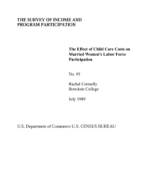The Effect of Child Care Costs on Married Women's Labor Force Participation
The Effect of Child Care Costs on Married Women's Labor Force Participation
The increase in women's labor force participation after World War I1 is a well known and well researched phenomenon. Much less well understood, however, is the central role that child care plays in that increase in the participation. The surge in women's labor force participation in the 1980s has been driven mainly by the rapid increase in the labor force participation of women with young children. In March 1985, half of all married women (with husband present) with a child less than two were in the labor force. Five years earlier, in 1980, the figure was 39%, while in 1970, the figure was 24%. As very few of these women care for their child while at work, most rely on an alternative caregiver. In some cases that caregiver is the husband or other family members, but the vast majority of women who participate in the formal labor market use a caregiver outside the immediate family. This alternative caregiver and the market for extra-family child care that brings parents and caregivers together, thus provides the mechanism for most women with young children to participate in the labor market.
Others in Series
Working Paper
Working Paper
Working Paper




